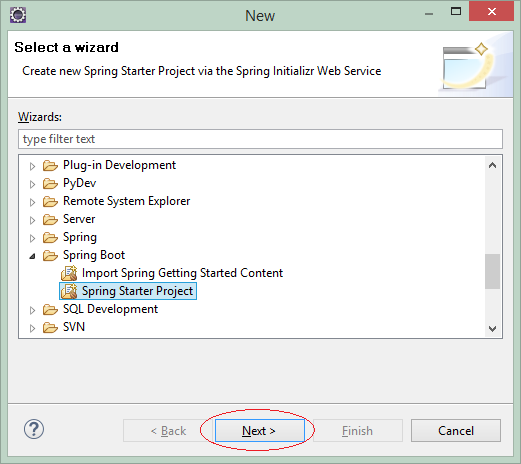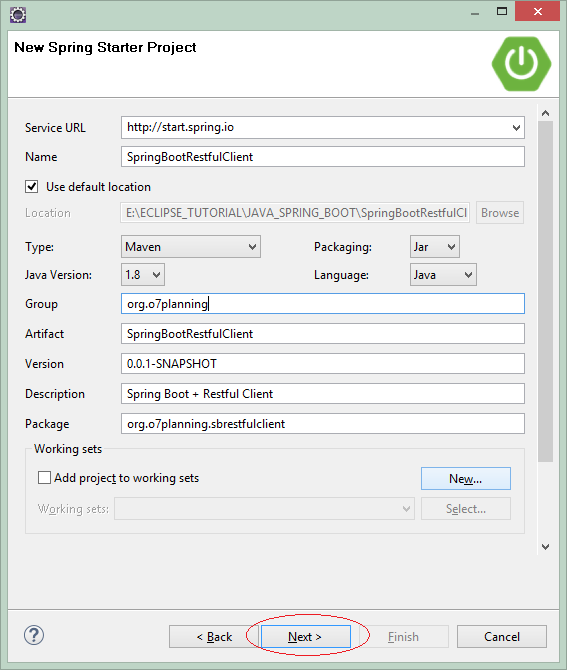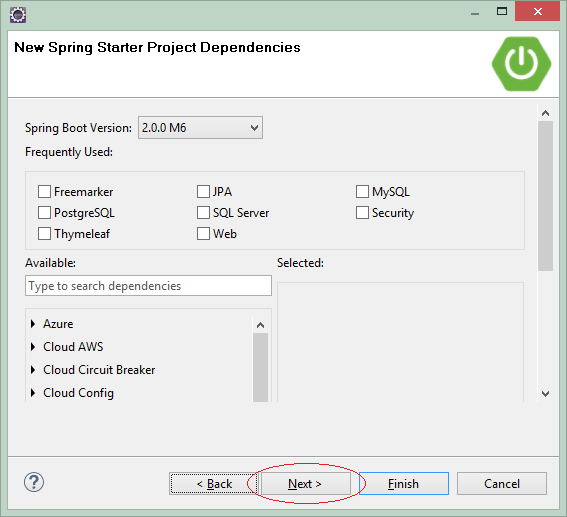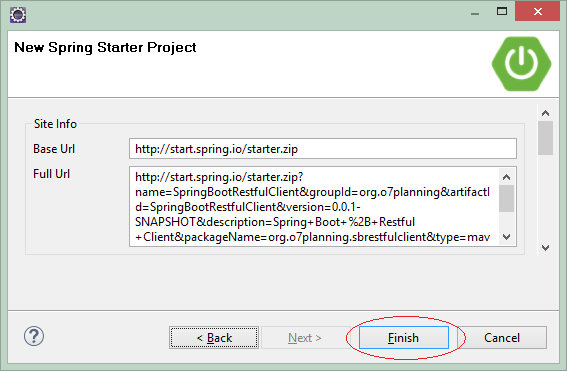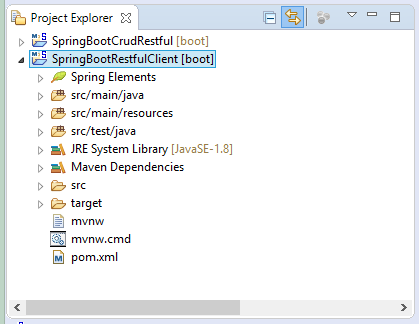Пример Spring Boot Restful Client c RestTemplate
1. Цель примера
Статья основана на:
- Spring Boot 2.x
- RestTemplate
- Eclipse 3.7
В данной статье я покажу вам как создать приложение Restful Client используя Spring Boot. С 4 функциями:
- Создать request с методом GET, отправить к Restful Web Service чтобы получить список сотрудников (employee), или информацию сотрудника. Полученные данные будут иметь формат XML или JSON.
- Создать request с методом PUT, отправить к Restful Web Service, чтобы запросить изменить информацию сотрудника, данные прикрепленные к request имеют формат XML или JSON.
- Создать request с методом POST, отправить к Restful Web Service чтобы добавить нового сотрудника, данные прикрепленные к request имеют формат XML или JSON.
- Создать request с методом DELETE, отправить к Restful Web Service чтобы удалить сотрудника.
Данная статья использует Restful Web Service созданные из следующего примера:
Класс RestTemplate является центральным классом в Spring Framework для синхронических вызовов (synchronous calls) сделанных с помощью Client для доступа к RESTful Web Service. Данный класс предоставляет функции для легкого потребления REST Services. При использовании вышеупомянутого класса, пользователь должен предоставить URL, параметры (если есть) и извлечь полученные результаты. RestTemplate контролирует соединения HTTP (HTTP Connection).
3. Конфигурация pom.xml
Данный Project должен использовать библиотеки Spring Restful Client. Поэтому у вас есть 2 выбора:
- spring-boot-starter-web
- spring-boot-starter-data-rest
spring-boot-starter-web
spring-boot-starter-web включает библиотеки для построения веб приложения используя Spring MVC, и использовать tomcat как Web Container по умолчанию. Включает библиотеки для приложения RESTful.
spring-boot-starter-web
<dependency>
<groupId>org.springframework.boot</groupId>
<artifactId>spring-boot-starter-web</artifactId>
</dependency>spring-boot-starter-data-rest
spring-boot-starter-data-rest включает библиотеки для работы с Spring RESTful.
spring-boot-starter-data-rest
<!-- https://mvnrepository.com/artifact/org.springframework.boot/spring-boot-starter-data-rest -->
<dependency>
<groupId>org.springframework.boot</groupId>
<artifactId>spring-boot-starter-data-rest</artifactId>
</dependency>Java <==> JSON
Оба "Starter" выше содержат библиотеку jackson-databind, поддерживающую конвертацию объекта Java в JSON и наоборот.
Java <==> XML
Spring использует JAXB (готовый в JDK) для конвертации объекта Java в XML и наоборот. Но классы Java должны быть аннотированы (annotate) с помощью @XmlRootElement,... Поэтому мой совет это вам стоит использовать jackson-dataformat-xml как библиотеку для конвертации XML и Java. Чтобы использовать jackson-dataformat-xml вам нужно его объявить в файле pom.xml:
jackson-dataformat-xml
<dependency>
<groupId>com.fasterxml.jackson.dataformat</groupId>
<artifactId>jackson-dataformat-xml</artifactId>
</dependency>OK, у вас есть 2 выбора для объявления в pom.xml:
** pom.xml (Option 1) **
<dependencies>
......
<dependency>
<groupId>org.springframework.boot</groupId>
<artifactId>spring-boot-starter-data-rest</artifactId>
</dependency>
<dependency>
<groupId>com.fasterxml.jackson.dataformat</groupId>
<artifactId>jackson-dataformat-xml</artifactId>
</dependency>
.....
</dependencies>** pom.xml (Option 2) **
<dependencies>
......
<dependency>
<groupId>org.springframework.boot</groupId>
<artifactId>spring-boot-starter-web</artifactId>
</dependency>
<dependency>
<groupId>com.fasterxml.jackson.dataformat</groupId>
<artifactId>jackson-dataformat-xml</artifactId>
</dependency>
.....
</dependencies>Необходимая библиотека Apache Commons Codec для кодирования (encode) username/password, в случае если вы используете Rest Client чтобы иметь доступ к ресурсам защищенным с помощью Basic Authentication.
<!-- https://mvnrepository.com/artifact/commons-codec/commons-codec -->
<dependency>
<groupId>commons-codec</groupId>
<artifactId>commons-codec</artifactId>
</dependency>Полное содержание файла pom.xml:
pom.xml
<?xml version="1.0" encoding="UTF-8"?>
<project xmlns="http://maven.apache.org/POM/4.0.0"
xmlns:xsi="http://www.w3.org/2001/XMLSchema-instance"
xsi:schemaLocation="http://maven.apache.org/POM/4.0.0
http://maven.apache.org/xsd/maven-4.0.0.xsd">
<modelVersion>4.0.0</modelVersion>
<groupId>org.o7planning</groupId>
<artifactId>SpringBootRestfulClient</artifactId>
<version>0.0.1-SNAPSHOT</version>
<packaging>jar</packaging>
<name>SpringBootRestfulClient</name>
<description>Spring Boot + Restful Client</description>
<parent>
<groupId>org.springframework.boot</groupId>
<artifactId>spring-boot-starter-parent</artifactId>
<version>2.0.0.RELEASE</version>
<relativePath/> <!-- lookup parent from repository -->
</parent>
<properties>
<project.build.sourceEncoding>UTF-8</project.build.sourceEncoding>
<project.reporting.outputEncoding>UTF-8</project.reporting.outputEncoding>
<java.version>1.8</java.version>
</properties>
<dependencies>
<dependency>
<groupId>org.springframework.boot</groupId>
<artifactId>spring-boot-starter</artifactId>
</dependency>
<dependency>
<groupId>org.springframework.boot</groupId>
<artifactId>spring-boot-starter-test</artifactId>
<scope>test</scope>
</dependency>
<dependency>
<groupId>org.springframework.boot</groupId>
<artifactId>spring-boot-starter-data-rest</artifactId>
</dependency>
<dependency>
<groupId>com.fasterxml.jackson.dataformat</groupId>
<artifactId>jackson-dataformat-xml</artifactId>
</dependency>
<!-- https://mvnrepository.com/artifact/commons-codec/commons-codec -->
<dependency>
<groupId>commons-codec</groupId>
<artifactId>commons-codec</artifactId>
</dependency>
</dependencies>
<build>
<plugins>
<plugin>
<groupId>org.springframework.boot</groupId>
<artifactId>spring-boot-maven-plugin</artifactId>
</plugin>
</plugins>
</build>
</project>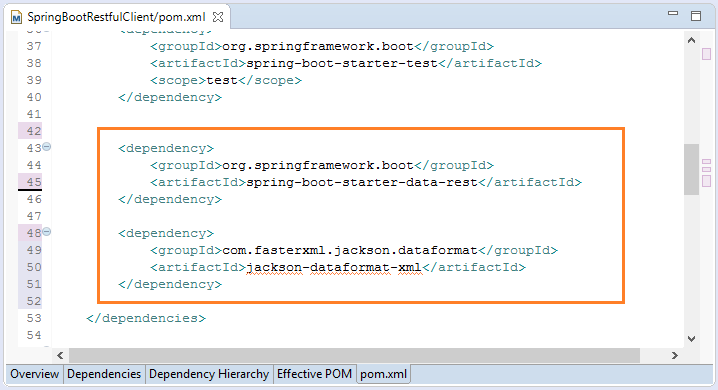
4. GET - getForObject
Использовать метод getForObject чтобы отправить запрос (request) к Restful Service, и получить возвращенные данные. Ниже являются самые простые примеры, возвращенные данные являются String.
SimplestGetExample.java
package org.o7planning.sbrestfulclient.get;
import org.springframework.web.client.RestTemplate;
public class SimplestGetExample {
static final String URL_EMPLOYEES = "http://localhost:8080/employees";
static final String URL_EMPLOYEES_XML = "http://localhost:8080/employees.xml";
static final String URL_EMPLOYEES_JSON = "http://localhost:8080/employees.json";
public static void main(String[] args) {
RestTemplate restTemplate = new RestTemplate();
// Send request with GET method and default Headers.
String result = restTemplate.getForObject(URL_EMPLOYEES, String.class);
System.out.println(result);
}
}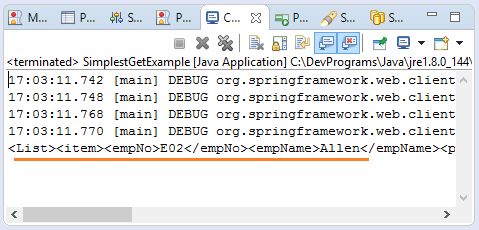
Запросы отправленные к Restful Service должны кастомизировать информацию Headers чтобы сказать Restful Service вид формата данных, который вы хотите получить (JSON, XML, ...)
GetWithHeaderExample.java
package org.o7planning.sbrestfulclient.get;
import java.util.Arrays;
import org.springframework.http.HttpEntity;
import org.springframework.http.HttpHeaders;
import org.springframework.http.HttpMethod;
import org.springframework.http.MediaType;
import org.springframework.http.ResponseEntity;
import org.springframework.web.client.RestTemplate;
public class GetWithHeaderExample {
static final String URL_EMPLOYEES = "http://localhost:8080/employees";
public static void main(String[] args) {
// HttpHeaders
HttpHeaders headers = new HttpHeaders();
headers.setAccept(Arrays.asList(new MediaType[] { MediaType.APPLICATION_JSON }));
// Request to return JSON format
headers.setContentType(MediaType.APPLICATION_JSON);
headers.set("my_other_key", "my_other_value");
// HttpEntity<String>: To get result as String.
HttpEntity<String> entity = new HttpEntity<String>(headers);
// RestTemplate
RestTemplate restTemplate = new RestTemplate();
// Send request with GET method, and Headers.
ResponseEntity<String> response = restTemplate.exchange(URL_EMPLOYEES, //
HttpMethod.GET, entity, String.class);
String result = response.getBody();
System.out.println(result);
}
}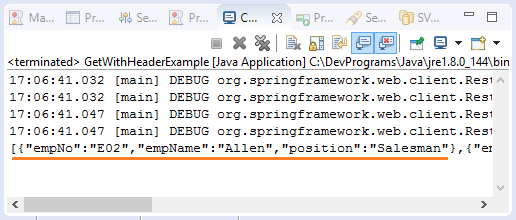
Данные возвращенные от Restful Serivce имеют формат XML или JSON, которые могут быть конвертированы (Convert) автоматически в объект Java.
Employee.java
package org.o7planning.sbrestfulclient.model;
public class Employee {
private String empNo;
private String empName;
private String position;
public Employee() {
}
public Employee(String empNo, String empName, String position) {
this.empNo = empNo;
this.empName = empName;
this.position = position;
}
public String getEmpNo() {
return empNo;
}
public void setEmpNo(String empNo) {
this.empNo = empNo;
}
public String getEmpName() {
return empName;
}
public void setEmpName(String empName) {
this.empName = empName;
}
public String getPosition() {
return position;
}
public void setPosition(String position) {
this.position = position;
}
}SimplestGetPOJOExample.java
package org.o7planning.sbrestfulclient.get;
import org.o7planning.sbrestfulclient.model.Employee;
import org.springframework.web.client.RestTemplate;
public class SimplestGetPOJOExample {
static final String URL_EMPLOYEES = "http://localhost:8080/employees";
static final String URL_EMPLOYEES_XML = "http://localhost:8080/employees.xml";
static final String URL_EMPLOYEES_JSON = "http://localhost:8080/employees.json";
public static void main(String[] args) {
RestTemplate restTemplate = new RestTemplate();
// Send request with GET method and default Headers.
Employee[] list = restTemplate.getForObject(URL_EMPLOYEES, Employee[].class);
if (list != null) {
for (Employee e : list) {
System.out.println("Employee: " + e.getEmpNo() + " - " + e.getEmpName());
}
}
}
}
5. GET - exchange
Использование метода exchange также поможет вам отправить request к Restful Service, возвращенный результат это объект ResponseEntity, данный объект содержит много иноформации заслуживающего внимания, как HttpStatus,...
GetPOJOWithHeaderExample.java
package org.o7planning.sbrestfulclient.get;
import java.util.Arrays;
import org.o7planning.sbrestfulclient.model.Employee;
import org.springframework.http.HttpEntity;
import org.springframework.http.HttpHeaders;
import org.springframework.http.HttpMethod;
import org.springframework.http.HttpStatus;
import org.springframework.http.MediaType;
import org.springframework.http.ResponseEntity;
import org.springframework.web.client.RestTemplate;
public class GetPOJOWithHeaderExample {
static final String URL_EMPLOYEES = "http://localhost:8080/employees";
public static void main(String[] args) {
// HttpHeaders
HttpHeaders headers = new HttpHeaders();
headers.setAccept(Arrays.asList(new MediaType[] { MediaType.APPLICATION_XML }));
// Request to return XML format
headers.setContentType(MediaType.APPLICATION_XML);
headers.set("my_other_key", "my_other_value");
// HttpEntity<Employee[]>: To get result as Employee[].
HttpEntity<Employee[]> entity = new HttpEntity<Employee[]>(headers);
// RestTemplate
RestTemplate restTemplate = new RestTemplate();
// Send request with GET method, and Headers.
ResponseEntity<Employee[]> response = restTemplate.exchange(URL_EMPLOYEES, //
HttpMethod.GET, entity, Employee[].class);
HttpStatus statusCode = response.getStatusCode();
System.out.println("Response Satus Code: " + statusCode);
// Status Code: 200
if (statusCode == HttpStatus.OK) {
// Response Body Data
Employee[] list = response.getBody();
if (list != null) {
for (Employee e : list) {
System.out.println("Employee: " + e.getEmpNo() + " - " + e.getEmpName());
}
}
}
}
}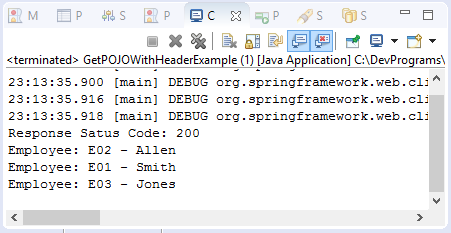
6. GET - Basic Authentication
Для ресурсов данных (resource) защищенных с помощью Basic Authentication, запросы (request) которые вы отправляете на REST Service должны прикреплять username/password. Информация username/password должна быть кодирована (encode) используя алгоритм Base64 перед тем как прикреплять с request.
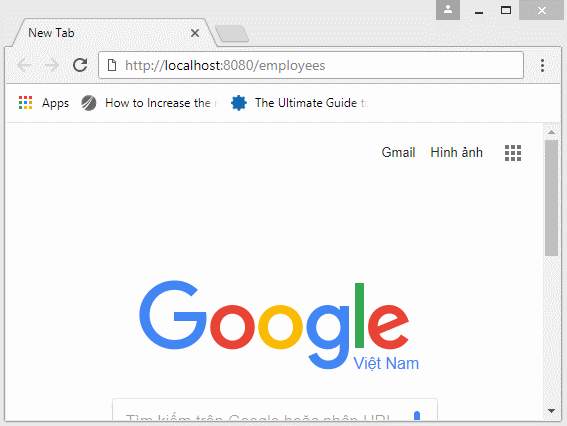
GetWithBasicAuthExample.java
package org.o7planning.sbrestfulclient.get;
import java.nio.charset.Charset;
import java.util.Arrays;
import org.springframework.http.HttpEntity;
import org.springframework.http.HttpHeaders;
import org.springframework.http.HttpMethod;
import org.springframework.http.MediaType;
import org.springframework.http.ResponseEntity;
import org.springframework.web.client.RestTemplate;
import org.apache.commons.codec.binary.Base64;
public class GetWithBasicAuthExample {
public static final String USER_NAME = "tom";
public static final String PASSWORD = "123";
static final String URL_EMPLOYEES = "http://localhost:8080/employees";
public static void main(String[] args) {
// HttpHeaders
HttpHeaders headers = new HttpHeaders();
//
// Authentication
//
String auth = USER_NAME + ":" + PASSWORD;
byte[] encodedAuth = Base64.encodeBase64(auth.getBytes(Charset.forName("US-ASCII")));
String authHeader = "Basic " + new String(encodedAuth);
headers.set("Authorization", authHeader);
//
headers.setAccept(Arrays.asList(new MediaType[] { MediaType.APPLICATION_JSON }));
// Request to return JSON format
headers.setContentType(MediaType.APPLICATION_JSON);
headers.set("my_other_key", "my_other_value");
// HttpEntity<String>: To get result as String.
HttpEntity<String> entity = new HttpEntity<String>(headers);
// RestTemplate
RestTemplate restTemplate = new RestTemplate();
// Send request with GET method, and Headers.
ResponseEntity<String> response = restTemplate.exchange(URL_EMPLOYEES, //
HttpMethod.GET, entity, String.class);
String result = response.getBody();
System.out.println(result);
}
}7. POST - postForObject
Метод postForObject используется для отправки request к Restful Service чтобы создать ресурс данных (resource), одновременно возвращает только что созданные ресурсы данных.
Post_postForObject_Example.java
package org.o7planning.sbrestfulclient.post;
import org.o7planning.sbrestfulclient.model.Employee;
import org.springframework.http.HttpEntity;
import org.springframework.http.HttpHeaders;
import org.springframework.http.MediaType;
import org.springframework.web.client.RestTemplate;
public class Post_postForObject_Example {
static final String URL_CREATE_EMPLOYEE = "http://localhost:8080/employee";
public static void main(String[] args) {
String empNo = "E11";
Employee newEmployee = new Employee(empNo, "Tom", "Cleck");
HttpHeaders headers = new HttpHeaders();
headers.add("Accept", MediaType.APPLICATION_XML_VALUE);
headers.setContentType(MediaType.APPLICATION_XML);
RestTemplate restTemplate = new RestTemplate();
// Data attached to the request.
HttpEntity<Employee> requestBody = new HttpEntity<>(newEmployee, headers);
// Send request with POST method.
Employee e = restTemplate.postForObject(URL_CREATE_EMPLOYEE, requestBody, Employee.class);
if (e != null && e.getEmpNo() != null) {
System.out.println("Employee created: " + e.getEmpNo());
} else {
System.out.println("Something error!");
}
}
}
8. POST - postForEntity
Метод postForEntity использованные для отправления request к Restful Service чтобы создать ресурс данных (resource). Данный метод возвращает объект ResponseEntity, этот объект содержит только что созданный ресурс данных, и другую важную информацию, например HttpStatus, ...
Post_postForEntity_Example.java
package org.o7planning.sbrestfulclient.post;
import org.o7planning.sbrestfulclient.model.Employee;
import org.springframework.http.HttpEntity;
import org.springframework.http.HttpStatus;
import org.springframework.http.ResponseEntity;
import org.springframework.web.client.RestTemplate;
public class Post_postForEntity_Example {
static final String URL_CREATE_EMPLOYEE = "http://localhost:8080/employee";
public static void main(String[] args) {
Employee newEmployee = new Employee("E11", "Tom", "Cleck");
RestTemplate restTemplate = new RestTemplate();
// Data attached to the request.
HttpEntity<Employee> requestBody = new HttpEntity<>(newEmployee);
// Send request with POST method.
ResponseEntity<Employee> result
= restTemplate.postForEntity(URL_CREATE_EMPLOYEE, requestBody, Employee.class);
System.out.println("Status code:" + result.getStatusCode());
// Code = 200.
if (result.getStatusCode() == HttpStatus.OK) {
Employee e = result.getBody();
System.out.println("(Client Side) Employee Created: "+ e.getEmpNo());
}
}
}9. PUT - Простой пример
Метод put класса RestTemplate используется для отправления request к Restful Service чтобы поменять ресурс данных (resource). Данный метод ничего не возвращает.
PutSimpleExample.java
package org.o7planning.sbrestfulclient.put;
import org.o7planning.sbrestfulclient.model.Employee;
import org.springframework.http.HttpEntity;
import org.springframework.http.HttpHeaders;
import org.springframework.http.MediaType;
import org.springframework.web.client.RestTemplate;
public class PutSimpleExample {
static final String URL_UPDATE_EMPLOYEE = "http://localhost:8080/employee";
static final String URL_EMPLOYEE_PREFIX = "http://localhost:8080/employee";
public static void main(String[] args) {
String empNo = "E01";
Employee updateInfo = new Employee(empNo, "Tom", "Cleck");
HttpHeaders headers = new HttpHeaders();
headers.add("Accept", MediaType.APPLICATION_JSON_VALUE);
RestTemplate restTemplate = new RestTemplate();
// Data attached to the request.
HttpEntity<Employee> requestBody = new HttpEntity<>(updateInfo, headers);
// Send request with PUT method.
restTemplate.put(URL_UPDATE_EMPLOYEE, requestBody, new Object[] {});
String resourceUrl = URL_EMPLOYEE_PREFIX + "/" + empNo;
Employee e = restTemplate.getForObject(resourceUrl, Employee.class);
if (e != null) {
System.out.println("(Client side) Employee after update: ");
System.out.println("Employee: " + e.getEmpNo() + " - " + e.getEmpName());
}
}
}10. PUT - exchange
Пример использования метода exchange класса RestTemplate для отправления request к Restful Service чтобы поменять ресурс данных.
PutWithExchangeExample.java
package org.o7planning.sbrestfulclient.put;
import org.o7planning.sbrestfulclient.model.Employee;
import org.springframework.http.HttpEntity;
import org.springframework.http.HttpHeaders;
import org.springframework.http.HttpMethod;
import org.springframework.http.MediaType;
import org.springframework.web.client.RestTemplate;
public class PutWithExchangeExample {
static final String URL_UPDATE_EMPLOYEE = "http://localhost:8080/employee";
static final String URL_EMPLOYEE_PREFIX = "http://localhost:8080/employee";
public static void main(String[] args) {
String empNo = "E01";
Employee updateInfo = new Employee(empNo, "Tom", "Cleck");
HttpHeaders headers = new HttpHeaders();
headers.add("Accept", MediaType.APPLICATION_JSON_VALUE);
RestTemplate restTemplate = new RestTemplate();
// Data attached to the request.
HttpEntity<Employee> requestBody = new HttpEntity<>(updateInfo, headers);
// Send request with PUT method.
restTemplate.exchange(URL_UPDATE_EMPLOYEE, HttpMethod.PUT, requestBody, Void.class);
String resourceUrl = URL_EMPLOYEE_PREFIX + "/" + empNo;
Employee e = restTemplate.getForObject(resourceUrl, Employee.class);
if (e != null) {
System.out.println("(Client side) Employee after update: ");
System.out.println("Employee: " + e.getEmpNo() + " - " + e.getEmpName());
}
}
}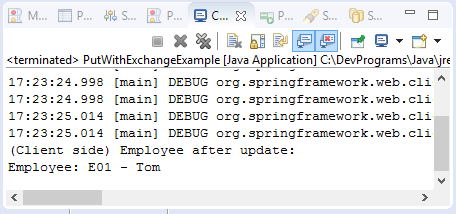
11. DELELE
Использовать метод delete класса RestTemplate чтобы отправить request к Restful Service для удаления ресурса данных.
DeleteSimpleExample.java
package org.o7planning.sbrestfulclient.delete;
import org.o7planning.sbrestfulclient.model.Employee;
import org.springframework.web.client.RestTemplate;
public class DeleteSimpleExample {
public static void main(String[] args) {
RestTemplate restTemplate = new RestTemplate();
// empNo="E01"
String resourceUrl = "http://localhost:8080/employee/E01";
// Send request with DELETE method.
restTemplate.delete(resourceUrl);
// Get
Employee e = restTemplate.getForObject(resourceUrl, Employee.class);
if (e != null) {
System.out.println("(Client side) Employee after delete: ");
System.out.println("Employee: " + e.getEmpNo() + " - " + e.getEmpName());
} else {
System.out.println("Employee not found!");
}
}
}DeleteExample2.java
package org.o7planning.sbrestfulclient.delete;
import org.o7planning.sbrestfulclient.model.Employee;
import org.springframework.web.client.RestTemplate;
public class DeleteExample2 {
public static void main(String[] args) {
RestTemplate restTemplate = new RestTemplate();
// URL with URI-variable
String resourceUrl = "http://localhost:8080/employee/{empNo}";
Object[] uriValues = new Object[] { "E01" };
// Send request with DELETE method.
restTemplate.delete(resourceUrl, uriValues);
Employee e = restTemplate.getForObject(resourceUrl, Employee.class);
if (e != null) {
System.out.println("(Client side) Employee after delete: ");
System.out.println("Employee: " + e.getEmpNo() + " - " + e.getEmpName());
} else {
System.out.println("Employee not found!");
}
}
}Руководства Java Web Services
- Что такое RESTful Web Service?
- Руководство Java RESTful Web Services для начинающих
- Простой пример CRUD с Java RESTful Web Service
- Создайте Java RESTful Client с помощью Jersey Client
- Отладчик RESTClient для RESTful WebServices
- Простой пример CRUD с Spring MVC RESTful Web Service
- Пример CRUD Restful Web Service c Spring Boot
- Пример Spring Boot Restful Client c RestTemplate
- Защита Spring Boot RESTful Service используя Basic Authentication
Show More
Руководства Spring Boot
- Установите Spring Tool Suite для Eclipse
- Руководство Spring для начинающих
- Руководство Spring Boot для начинающих
- Общие свойства Spring Boot
- Руководство Spring Boot и Thymeleaf
- Руководство Spring Boot и FreeMarker
- Руководство Spring Boot и Groovy
- Руководство Spring Boot и Mustache
- Руководство Spring Boot и JSP
- Руководство Spring Boot, Apache Tiles, JSP
- Используйте Logging в Spring Boot
- Мониторинг приложений с помощью Spring Boot Actuator
- Создание веб-приложения с несколькими языками с помощью Spring Boot
- Используйте несколько ViewResolver в Spring Boot
- Используйте Twitter Bootstrap в Spring Boot
- Руководство Spring Boot Interceptor
- Руководство Spring Boot, Spring JDBC и Spring Transaction
- Руководство Spring JDBC
- Руководство Spring Boot, JPA и Spring Transaction
- Руководство Spring Boot и Spring Data JPA
- Руководство Spring Boot, Hibernate и Spring Transaction
- Интеграция Spring Boot, JPA и H2 Database
- Руководство Spring Boot и MongoDB
- Используйте несколько DataSources с Spring Boot и JPA
- Используйте несколько DataSource с Spring Boot и RoutingDataSource
- Создайте приложение для входа с Spring Boot, Spring Security, Spring JDBC
- Создайте приложение для входа с Spring Boot, Spring Security, JPA
- Создайте приложение регистрации пользователей с помощью Spring Boot, Spring Form Validation
- Пример OAuth2 Social Login в Spring Boot.
- Запускать фоновые запланированные задачи в Spring
- Пример CRUD Restful Web Service c Spring Boot
- Пример Spring Boot Restful Client c RestTemplate
- Пример CRUD с Spring Boot, REST и AngularJS
- Защита Spring Boot RESTful Service используя Basic Authentication
- Защита Spring Boot RESTful Service используя Auth0 JWT
- Пример Upload file c Spring Boot
- Пример Download file c Spring Boot
- Пример Upload file c Spring Boot и jQuery Ajax
- Пример Upload file c Spring Boot и AngularJS
- Создание веб-приложения для корзины покупок с помощью Spring Boot, Hibernate
- Руководство Spring Email
- Создайте простое приложение Chat с Spring Boot и Websocket
- Разверните приложение Spring Boot на Tomcat Server
- Развертывание приложения Spring Boot на Oracle WebLogic Server
- Установите бесплатный сертификат Let's Encrypt SSL для Spring Boot
- Настройте Spring Boot для перенаправления HTTP на HTTPS
Show More
